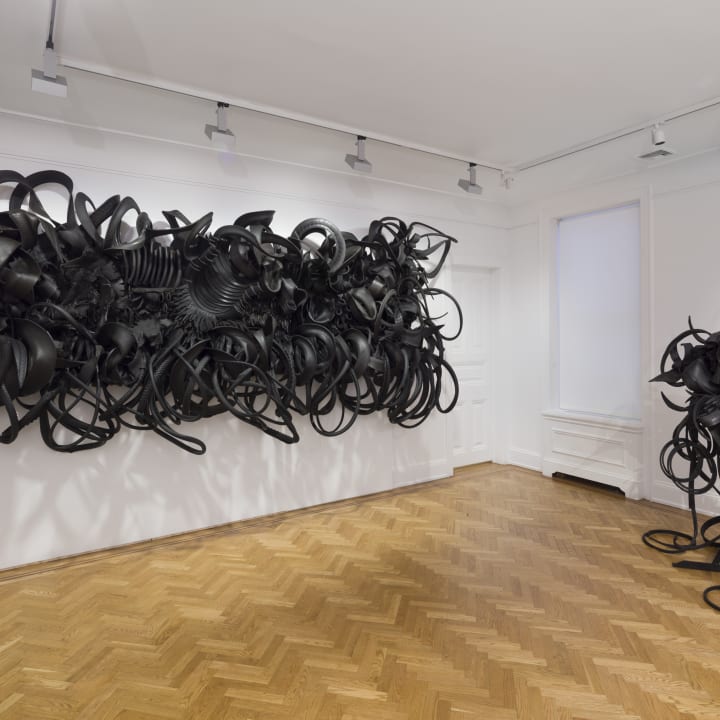At David Nolan’s townhouse space this November, one does not see but smells the art first. A double door opens onto a long, narrow corridor linking two air-tight rooms, one of which exudes a faint but distinct odor—the kind you would expect to find in garages, workshops, or factories. It is the smell of industrial manufacturing—of things being made and synthetically transformed—a strange olfactory mix of newness and debris. I found my way by following the scent until I encountered a futuristic being made entirely out of found tires; its surface is layered, its twisted parts writhing, reaching for me, and expanding toward the ceiling, as if striving to break away from the wall from which it had sprung.
Chakaia Booker’s craft is such that anything she makes must have come from the future. Frank Stella’s “Moby Dick” assemblages, in comparison, look like children’s playthings. To make Empty Seat (2006), Booker salvaged burnt or collapsed tires from around the city, which she then cut, sheared, warped, and riveted onto one another and onto a wooden backing; my verbs by no means exhaust the multitude of techniques involved here. Such demanding processes have become her signature, and, as the gallery’s concise selection of works shows, she has perfected them with astounding focus over the past three decades. The cyborgian creature in its bacchanalian dance and entropic unraveling positions the viewer in a constant push and pull between the desire to look closely—to follow the coiled rubber, to witness its intricate unfolding—and a temporal paralysis in the face of its sheer grandeur, its ceremonial scale. Its six-by-fifteen-by-two cubic-foot volume opens onto an infinite field of forms that is morphing at every angle, almost precipitating what Édouard Glissant has called the “vertigo of unveiling,” in which seeing “unveils something veiled that never becomes purely unveiled but exposes itself in the very mechanism of unveiling.” Faced with these shape-shifting rubber forms and their surface patterns that occasionally flash into view with a quasi-metallic sheen, vision is destabilized as it dissolves into splinters of light that are in fact the myriad reflections of darkness.
The presentation of four tire-based works from different periods in Booker’s career—and a concurrent public art project (Shaved Portions [2024]) on view at Broadway and West 39th St—traces the gradual expansion of her practice from the gallery wall to the viewer’s space, and further, into urban and social environments. In the earliest work on display, Untitled(1996), a wooden picture frame struggles to contain the swarm of deconstructed tires, whose feverish contortions make Jackson Pollock’s drip paintings seem decorative. Already heralded in this work is the material’s inevitable growth out of the apparatus of painting—as in Empty Seat—into real space, as in the biomorphic cluster of Bottom Half (2008) and Strayed (2019), where strips of tires hang loose from a metal prop, draping, curling, and spilling onto the floor.
But the centerpiece of the show is undoubtedly Empty Seat; its dancing shadows loom above the viewer, begging comparison with Kara Walker’s theaters of cut-paper silhouettes. Indeed, the oscillation between presence and absence in both Booker’s and Walker’s works allegorizes the dialectical tension between memory and forgetting, one already signaled in Booker’s title’s play of vacancy and fullness. Tires, after all, feature prominently in the iconography of the techno-industrial age, symbolizing speed and built-in obsolescence. At the same time, the materiality of rubber indexes the collective trauma of slave plantations and the ongoing violence accompanying the global spread of extractive capitalism. Yet the crucial difference between Booker’s work and the Duchampian model of found-object sculpture is her treatment of her readymades—such that the latter are utterly transformed while remaining inscribed by their social context and material histories. Empty Seattherefore serves as both a countermemory (a viscerally material archive) and what Ekow Eshun has called the “articulation of futures in the everyday,” where the past and the present are inextricably implicated in the production of a counter-hegemonic future.
Then there is the uniform palette of these works, which stems from the addition of carbon black to rubber in tire manufacturing and the artist’s thorough cleaning process. (This is not always the case with her earlier works like Untitled (male torso that left his path) (1993), where dirt and discoloration are integral to the composition). By fully adopting the monochrome as a site of intervention, Booker participates in a genealogy of artists critically engaged with the modernist legacy of Kazimir Malevich’s Black Square (1915). Like Ellen Gallagher or Louise Nevelson, Booker mobilizes Blackness as at once a lived collective experience and a racial designation by creating figure/ground differentials within pigmented blackness. In Empty Seat, and throughout Booker’s oeuvre, the exposed bead-wire structure of the tires, their surface designs that she deems “abstractly African,” and the linear emphasis in their forms generate a singular narrative capacity. Worn tires are not merely recuperated but rendered anew—into a potent language for the artist’s fantastical prolepses.

